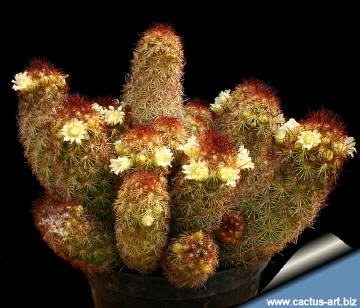|
|
|

The 'Copper King' cultivar has showy copper
colored spines on the top.
This plant is sometimes called 'Lady Fingers' because of its harmless
spines, it will occupy a small flower pot comfortably and remain a
manageable sized house plant.
|
|

E. elongata is a clustering plants that form pencil to finger-like
stems. |
Description:
M. elongata is a succulent ground cover, forming with time a
tight clumps of erect, ascending, prostrate or recumbent stems.
This may be the most common Mammillaria to be found and occurs in more
variations than any other Mammillaria species. It commonly comes in many
colour and spine variations.
Stems: Elongated cylindrical, finger-like, 1 - 3 cm in diameter3-10
cm long.
Roots: Fibrose.
Tubercle: Tubercles slender conical arranged in perfect spiral in
a few rows.
The axil is naked or nearly so.
Areoles: Pubescent when young.
Radial spine: 14 - 25 interlocking, arranged as a star, variable in number,
white to golden yellow to brown, the degree of brown colouring varying
from plant to plant, slender, needle-like, more or lessrecurved 4 - 12 mm long.
Central spine: Usually absent, sometimes 2, yellow to brownish,
with dark tips, 10 - 15 mm long. Perianth segments about 12, rather
broad, obtuse or sometimes apiculate. |
|
Flower: At the upper part of the plant, whitish, pale yellow or pinkish, sometimes flushed pink or with
pink midstripes, to 10 mm long and in diameter.
Blooming season (Europe): Spring, but can bloom for a second time later in
the year.
Fruit: Pink, becoming red.
Seed: Brown.
Note:
This is a popular species, but many cultivated forms are hybrids,
especially with Microhelia.
The subspecies 'echinaria' is different in that it has 2-3
dark central spines. Unlike the subspecies 'elongata' which has none or
very short central spines if any.
Cultivation:
This is a popular and
easy cactus species.
It will form quite large
clumps with hundreds of offsets if given time and grown properly. It is
especially suited for window sill and dish gardens. Water regularly from
spring through fall, but do not overwater (Rot prone) Let soil become
moderately dry between thorough waterings. In winter, keep dry or water
only enough to keep the plants from shriveling. Use pot with good
drainage and a very porous potting media. Newly
potted plants should not be fertilized for a year; established plants
should be fertilized once each spring
with a high potassium
fertilizer.
It is quite frost resistant if kept dry, hardy as low as -4°
C. Outside full sun
or afternoon shade, inside needs bright light, and some direct sun, but
high levels of light will encourage tight growth and flowering.
Easily flowered.
Propagation:
This species
produce clumps of young plants at the base of the main stem, these can
be removed at any time of the year.
It can also be grown from
seed.
|
|
Advertising
|
|
|
|
|
Family:
Cactaceae (Cactus
Family) |
|
Scientific name:
Mammillaria elongata DC.
Rev. Fam. Cact. in Mém. Mus. Hist. Nat. Paris 17: 109
(1828)
Origin: Mammillaria elongata is a
native of Central Mexico (Hidalgo, Guanajuato, and Queretaro). Altitude
1.350 to 2.400 m. "Copper King" is a
nursery produced cultivar.
Conservation status: Listed in
CITES appendix 2.
Common Names include: Lady Fingers,
Golden star cactus
Etymology: "elongata"
Meas
elongated.
|
Synonyms:
- Neomammillaria
elongata (DC.) Britton & Rose
Cact. 4:134. 1923
- Cactus elongatus
- Leptocladodia elongata
- Krainzia elongata
- Chilita elongata
- Mammillaria
stella-aurata
Heterotypic synonyms:
- M. elongata var
anguinea
- M. elongata var densa
- M. elongata var
echinata
- M. elongata var
intertexta
- M. elongata var
rufrocrocea
- M. elongata var stella-aura
- M. elongata var
straminea
- M. elongata var
subcrocea
- M. elongata var tenuis
- M. elongata var
viperina
|
|
|
|

The pale yellow flowers
contrast with the dark coloured spines.
|
|
Photo of conspecific taxa, varieties, forms and
cultivars of Mammillaria elongata.

 |
|